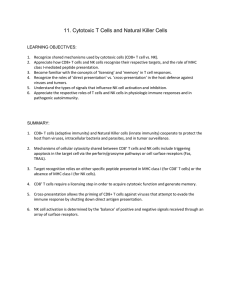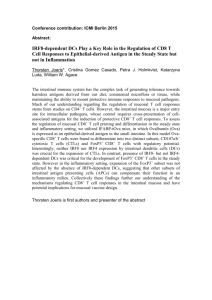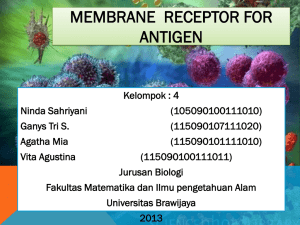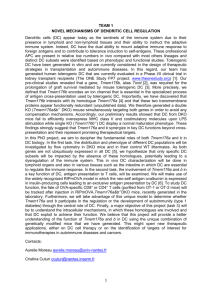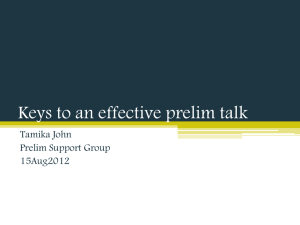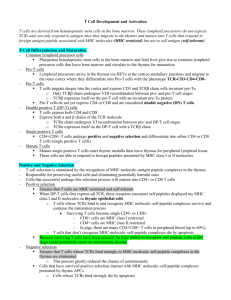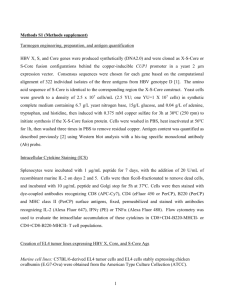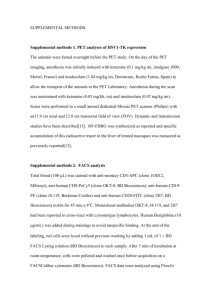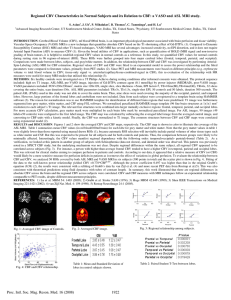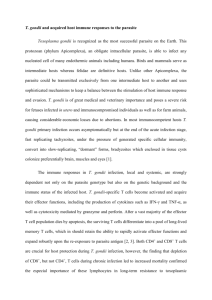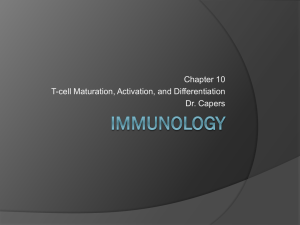Designing CD8+ T cell vaccines
advertisement
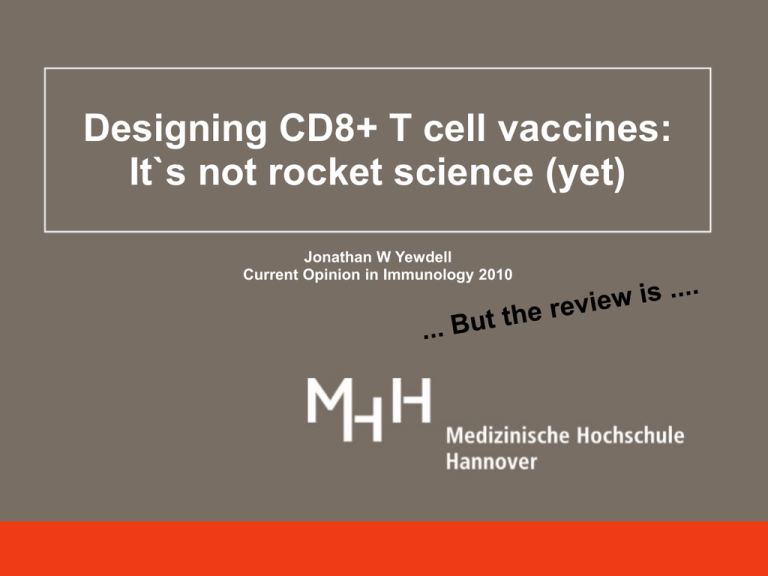
Designing CD8+ T cell vaccines: It`s not rocket science (yet) Jonathan W Yewdell Current Opinion in Immunology 2010 CD8+ vaccines Therapeutic cervical cancer vaccination Function of CD8+ T cells: 13 diff. HPV peptides + Freud`s adjuvants - clearance of viral infections - tumor immunity BUT tumors have good ImmuneEscape strategies CD8+ response HPV induced cervical tumor Yewdell et al., Nat Rev Imm, 2003 Zur Anzeige wird der QuickTime™ Dekompressor „“ Data from: Welters et al., Clin Cacer Res. 2008; Kenter et al., N Engl J Med., 2009 Activation of CD8+ T cells Aim: Induction of tumor-specific Tmem for therapeutic cancer vaccination Extracellular antigen Cross-presentation APC APC Intracellular antigen APC MHC MHC II I MHC I CD4+ cell CD8+ TT cell e.g. bacteria e.g. dying cells, proteins, peptides CD8+ T cell e.g. viruses Cross-Presentation MHC I Phagosome - to cytosol - pathway endolysosome Vacuolar pathway Cat S MHC I TAP ER Proteasome Vaccine Strategies What is the desired response? -What peptides? - response should be as minimal as possible to avoid side-effects and induction of tolerance - What Types of CD8+ T cells? - What anatomic locations should be focused of the response? How should this response be generated? - What immunogens should be used - What dose and - Which route? - How many boosts? Mouse models BUT mice are still not human How can we learn from cross-priming? (2) APC modification (3) Drug modulation of antigen processing loss of cross-priming via: CD8 CD103 - Bortezomib inhibits Proteasome - Chloroquine enhances cytosolic delivery Zur Anzeige wird der QuickTime™ Dekompressor „“ benötigt. - CD8-/CD103- DCs Endolysosome Zu r A nzei ge wi rd d er Qui ckT ime™ Deko mpre sso r „“ be nöt ig t. - injection of proapopt. CytochromeC - DC preactivation Zu r A nzei ge wi rd d er Qui ckT ime™ Deko mpre sso r „“ be nöt ig t. Zu r A nzei ge wi rd d er Qui ckT ime™ Deko mpre sso r „“ be nöt ig t. (4) Genetic modulation of antigen processing - KO of endosomal protease IRAP (1) MHC I Trafficking - mod. Cytoplasmic domain no travelling to endolysosome Yewdell et al., Nat Rev Imm, 2003 Antigen for cross-priming: Proteins vs. peptides - Proteins favoured - antigen stability important - peptides have to metabolically stable (law of mass action) -BUT: chaperoned pepetides might Zur Anzeige wird der QuickTime™ Dekompressor „“ benötigt. gp96 Zu r Anze ig e w ir d der Quick Time ™ De ko m p r ess o r „“ be nö t ig t. work High immunogenicity - Immnunogenicity highly dependant on cargo - e.g adjuvant effect of secreted gp96 Yewdell et al., Nat Rev Imm, 2003 Antigen acquisition in cross-priming - Cell-delivered antigens - Nibbling from alive cells - Phagocytosis of dead cells - Trogocytosis / „cross-dressing“ -Acquire preformed C1PCs from other APCs during cellular interactions (e.g. from monocytes which phagocytosed dead cell antigens) - even TCRs can be exchanges between naive T cells and CD8+ T cells - Peptide transfer via gap junctions (but more in direct priming) - Expression of cell death signals enhances cross-presenation - CLEC9A a necrotic cell detector - selectively expressed by CD8+ and plasmacytoid DCs Who is priming? - Cross-priming appears to be dependant on CD8+ CD103+ DCs - CD8 features: optimizing endolysosome pH, CLEC9A regulated cross-priming - CD103+ DCs: migrating subset, transport antigen from periphery to LN - But in humans? - maybe BDCA3+ DC similar to CD8+ DC in mouse -pAPC „Wannabes“ capable of cross-priming: -pDCs, IFN producing killer DCs, neutrophils (but not in significant quantities?) Some “practical advice” - Cross-priming is optimized by expressing long-lived antiges - extended peptide have increased immunogenicity because of resistance to protease destruction - advances in material science offer great promise for polypeptide-based vaccines: Immunigenicity is increased when delivering antigen and TLRactivating substances in the same particle Conclusion Still a lot to do in science before we really understand cross-priming vaccineattention! strategies Thank youbased for your Questions ???
